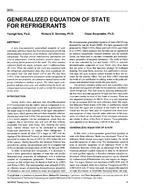This paper documents the first known hot box test of a straw bale wall. The results led the authors on an investigative search for analytical solutions that accurately predicted the heat transfer occurring under steady-state hot box tests. The measured steady-state R-value of this two-tie wheat-straw bale wall does not agree with frequently assumed R-values for straw bale walls, based on limited individual bale thermal resistivity measurements. The hot box measurement area for this test wall was 2.4 m by 2.4 m (8 ft by 8 ft). Frequently reported R-values of straw bale walls are between 7 and 10.5 m2 · °C/W (40-60 h·ft2· °F/Btu). The measured steady-state R-value for the straw bale wall, built according to the Tucson, Arizona, structural code, was 2.8 m2 ·C/W (16 h·ft2 ·°F/Btu). Total thickness of the complete wall was about 51 cm (20 in.). Test wall layers consist of 47 cm (18 in) thick bales stacked with the straws oriented perpendicular to the wall surfaces, the outside surfaced with stucco containing chicken wire lath, and the inside surfaced with two layers of 1.3 cm (Â in.) thick gypsum drywall mechanically fastened to 5 cm × 10 cm (2 in.× 4 in.) stakes pounded into the straw bales on 61 cm (2 ft) centers. Thermal conductivity and air permeability measurements of the straw material are reported, with the straw oriented both parallel and perpendicular to the direction of air and heat flow. Several analytical models using the laboratory straw material property measurements as input are employed to generate analytical predictions for comparison with the hot box results. Natural convection within the wall was the major cause for the surprisingly low R-value hot box measurement. The convective loop formed within the wall follows a path starting with air rising between the straw bales and the drywall on the warm side, through the straws in the top row of bales, falling on the cold side between the straw and the stucco, through the bottom straws, and back to the air gap between the straw and the drywall on the warm side. A computational fluid dynamics model helped uncover that the natural convection does not occur predominately through the straw itself. The natural convection can occur within the gaps between the straw and the surface treatments on both the interior and exterior sides. The authors conclude that with careful application of interior plaster and exterior stucco, straw bale wall builders can build “natural convection free.” Follow-up tests confirm that the major impacts of natural convection can be eliminated, which results in an R-value about 60% higher then the first wall reported in this paper.
AUTHOR: Jeffrey E. Christian, Andre O. Desjarlais, Therese K. Stovall, P.E.
CITATION: Thermal Performance of the Exterior Envelopes of Buildings VII
KEYWORDS: December, Florida, 1998
YEAR: 1998
Citation: Thermal Performance of the Exterior Envelopes of Buildings VII
Product Details
- Published:
- 1998
- File Size:
- 1 file , 1.9 MB
- Product Code(s):
- D-8093


